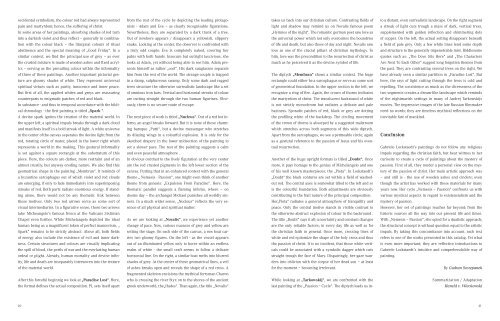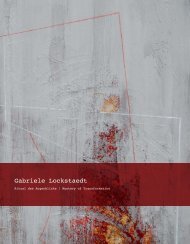Gabriele Lockstaedt NEMESIS
Gabriele Lockstaedt NEMESIS
Gabriele Lockstaedt NEMESIS
Sie wollen auch ein ePaper? Erhöhen Sie die Reichweite Ihrer Titel.
YUMPU macht aus Druck-PDFs automatisch weboptimierte ePaper, die Google liebt.
occidental symbolism, the colour red had always represented<br />
pain and martyrdom; hence, the suffering of christ.<br />
In some areas of her paintings, absorbing shades of red turn<br />
into a darkish violet and thus reflect – generally in combination<br />
with the colour black – the liturgical colours of ritual<br />
abstinence and the special meaning of „Good Friday“. In a<br />
similar context, we find the principal use of grey – as ever<br />
the crusted mixture is made of wooden ashes and fixed acrylics<br />
– serving as the prevailing colour within the informality<br />
of three of these paintings. Another important pictorial gesture<br />
are gloomy shades of white. They represent universal<br />
spiritual virtues such as purity, innocence and inner peace.<br />
But first of all, the applied whites and greys are reassuring<br />
counterparts to enigmatic patches of red and black.<br />
In substance - and thus in temporal accordance with the biblical<br />
chronology - the first painting is titled „Spark “.<br />
A devine spark ignites the creation of the material world. In<br />
the upper left, a spiritual impuls breaks through a dark cloud<br />
and manifests itself in a bold streak of light. A white universe<br />
in the center of the canvas seperates the devine light from the<br />
red, rotating circle of mater, placed in the lower right which<br />
represents a world in the making. This gestural informality<br />
is set against a square rectangle at the substratum of this<br />
piece. Here, the colours are darker, more restraint and of an<br />
almost crustily, but anyway eroding nature. We also find this<br />
geomatrical shape in the painting „Membran“. It reminds of<br />
a byzantine sarcophagus out of which violet and red clouds<br />
are emerging, if only to fade immediately into superimposing<br />
streaks of red. Both parts radiate enormous energy. If standing<br />
alone, there would not be any thematic link between<br />
those motives. Only two red arrows serve as some sort of<br />
visual intermediaries. In a figurative sense, those two arrows<br />
take Micheangelo’s famous fresco at the Vaticans Sixtinian<br />
Chapel even further. While Michelangelo depicted the ideal<br />
human being as a magnificent token of perfect mannerism, „<br />
Spark“ remains to be strictly abstract. Above all, both fields<br />
of energy also include the existence of evil and inner darkness.<br />
Certain structures and colours are visually implicating<br />
the spill of blood, the perils of war and the everlasting human<br />
ordeal or plight. Already, human mortality and devine infinity,<br />
life and death are inseparably interwoven into the texture<br />
of the material world.<br />
After this forceful beginnig we look at „Paradise Lost“. Here,<br />
the format defines the actual composition. PL sets itself apart<br />
from the rest of the cycle by depicting the leading protagonists<br />
- Adam and Eve – as clearly recognisable figurations.<br />
Nevertheless, they are separated by a dark trunk of a tree.<br />
Out of nowhere appears / disappears a yellowish, slippery<br />
snake. Looking at the center, the observer is confronted with<br />
a truly odd couple: Eve is completely naked, covering her<br />
pubis with both hands. Insecure but outright lascivious, she<br />
looks at Adam, yet without being able to see him. Adam presents<br />
himself as rather „cool“. His dark sunglasses separate<br />
him from the rest of the world. The strange couple is trapped<br />
in a damp, sulphureous swamp. Only some dark and ragged<br />
trees structure the otherwise surrealistic landscape like a set<br />
of omnious iron bars. Vertical and horizontal streaks of colour<br />
are cutting straight through the two human figurines. Obviously,<br />
there is no secure route of escape.<br />
The next piece of work is titled „Nucleus“. Out of a red hot inferno,<br />
an angel breaks forward. But it is none of those charming<br />
baroque „Putti“, but a devine messenger who stretches<br />
its dilating wings in a colourful explosion. It is only for the<br />
sketched drapery in the lower midsection of the painting to<br />
set a slower pace. The rest of the painting suggests a calm<br />
and even peaceful atmosphere .<br />
In obvious contrast to the lively figuration at the very center<br />
are the red crusted pigments in the left lower section of the<br />
canvas. Putting that in an enhanced context with the general<br />
theme „ Nemesis - Passion“, one might even think of another<br />
theme from genesis: „Expulsion From Paradise“. Here, the<br />
thematic parallel suggests a flaming inferno, where – on<br />
dooms day – the archangel Michael punishes all worldly sinners.<br />
In a much wider sense, „Nucleus“ reflects the very essence<br />
of all physical and spiritual matter.<br />
As we are looking at „Novalis“, we experience yet another<br />
change of pace. Now, various nuances of grey and yellow are<br />
setting the stage. On each side of the canvas, a row boat carries<br />
two gloomy figures. On the left - as the vessel appears<br />
out of an illuminated yellow only to hover within an endless<br />
realm of white - the small craft seems to follow a delicate<br />
horizontal line. On the right, a similar boat melts into blurred<br />
shades of grey. At the center of these geomatrical lines, a veil<br />
of ashes breaks open and reveals the shape of a red cross. A<br />
fragmented skeleton envisions the mythical ferryman Charon<br />
who is crossing the river Styx on to the shores of the ancient<br />
greek underworld, the„Hades“. Than again, the title „Novalis“<br />
takes us back into our christian culture. Contrasting fields of<br />
light and shadow may remind us on Novalis famous poem<br />
„Hymnos of the night“. The romantic german poet saw love as<br />
the universal power which not only overcomes the boundries<br />
of life and death, but also those of day and night. Novalis saw<br />
love as one of the crucial pillars of christian mythology. To<br />
him, love was the precondition to the resurrection of christ as<br />
much as he perceived it as the devine symbol of life.<br />
The diptych „Membran“ shows a similar context. The huge<br />
rectangle could either be a sarcophagus or serve as some sort<br />
of geometrical foundation. In the upper section to the left, we<br />
recognize a ring of fire. Again, the crown of thorns indicates<br />
the martyrdom of christ. The translucent backround of white<br />
is not strictly monochrom but radiates a delicate and pale<br />
haziness. Sporadic patches of red, black or grey are dotting<br />
the profiling white of the backdrop. The circling movement<br />
of the crown of thorns is absorped by a suggested malstroem<br />
which stretches across both segments of this wide diptych.<br />
Apart from the sarcophagus, we see a permeable circle; again<br />
as a gestural reference to the passion of Jesus and his eventual<br />
resurrection.<br />
Another of the huge upright formats is titled „Doubt“. Once<br />
more, it pays homage to the genius of Michelangelo and one<br />
of his well known masterpieces; the „Pieta“. In <strong>Lockstaedt</strong>’s<br />
„Doubt“ the black contures are set within a field of washedout<br />
red. The central axes is somewhat tilted to the left and so<br />
is the colourful foundation. Both adjustments are obviously<br />
contributing to the frail nature of the principal composition.<br />
Her„Pieta“ radiates a general atmosphere of tranquility and<br />
peace. Only the central motive stands in visible contrast to<br />
the otherwise abstract explosion of colour in the backround .<br />
The title „Doubt“ says it all; uncertainty and constant changes<br />
are the only reliable factors; in every day life as well as for<br />
the christian faith in general. Once more, crossing lines of<br />
white and red epitomize the shape of the holy cross and thus<br />
the passion of christ. It is no incident, that those white verticals<br />
could be associated with a symbolic dagger which cuts<br />
straight trough the face of Mary. Dispairingly, her gaze wanders<br />
into oblivion with the corpse of her dead son – at least<br />
for the moment – becoming irrelevant.<br />
While looking at „Tarkowskij“, we are confronted with the<br />
last painting of the „Passion – Cycle“. The diptych leads us into<br />
a distant, even surrealistic landscape. On the right segment<br />
a streak of light cuts trough a mass of dark, vertical tress,<br />
supplemented with golden reflection and shimmering dots<br />
of copper. On the left, the actual setting disappears beneath<br />
a field of pale grey. Only a few white lines lend some depth<br />
and structure to the generally impenetrable mist. Riddlesome<br />
quotes such as: „The Dove Sits Here“ and „The Characters<br />
Are Next To Each Other“ suggest long forgotten themes from<br />
the past. They are contrasting several trees on the right. We<br />
have already seen a similar partition in „Paradise Lost“. But<br />
here, the rays of light cutting through the tress is cold and<br />
repelling. The coexistence as much as the diverseness of the<br />
two segments creates a dream-like landscape which reminds<br />
of the nightmarish settings in many of Andrej Tarkowskijs<br />
movies. The impressive images of the late Russian filmmaker<br />
need no words; they are timeless mythical reflections on the<br />
inevitable fate of mankind.<br />
Conclusion<br />
<strong>Gabriele</strong> <strong>Lockstaedt</strong>’s paintings do not follow any religious<br />
impuls regarding the christian faith, but bear wittnes to her<br />
curiosity to create a cycle of paintings about the mystery of<br />
passion. First of all, they render a personal view on the mystery<br />
of the passion of christ. Her main artistic approach was<br />
– and still is - the use of wooden ashes and cinders; even<br />
though the artist has worked with these materials for many<br />
years now. Her cycle „Nemesis – Passion“ confronts us with<br />
various mystical aspects in regard to existensialism and the<br />
mystery of passion.<br />
However, her set of paintings reaches far beyond; from the<br />
historic sources all the way into our present life and times.<br />
With „Nemesis – Passion“, she opted for a dualistic approach;<br />
the structural concept is without question equal to the artistic<br />
impuls. By taking this concomitance into account, each text<br />
refers to one of the works presented in this catalog. Yet what<br />
is even more important; they are reflective introductions to<br />
<strong>Gabriele</strong> <strong>Lockstaedt</strong>’s intuitive and comprehendsible way of<br />
painting.<br />
By Gudrun Szczepanek<br />
Summarization / Adaptation<br />
Harald v. Wieckowski<br />
40 41



